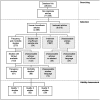Clinical manifestations of human brucellosis: a systematic review and meta-analysis
- PMID: 23236528
- PMCID: PMC3516581
- DOI: 10.1371/journal.pntd.0001929
Clinical manifestations of human brucellosis: a systematic review and meta-analysis
Abstract
Background: The objectives of this systematic review, commissioned by WHO, were to assess the frequency and severity of clinical manifestations of human brucellosis, in view of specifying a disability weight for a DALY calculation.
Methods/principal findings: Thirty three databases were searched, with 2,385 articles published between January 1990-June 2010 identified as relating to human brucellosis. Fifty-seven studies were of sufficient quality for data extraction. Pooled proportions of cases with specific clinical manifestations were stratified by age category and sex and analysed using generalized linear mixed models. Data relating to duration of illness and risk factors were also extracted. Severe complications of brucellosis infection were not rare, with 1 case of endocarditis and 4 neurological cases per 100 patients. One in 10 men suffered from epididymo-orchitis. Debilitating conditions such as arthralgia, myalgia and back pain affected around half of the patients (65%, 47% and 45%, respectively). Given that 78% patients had fever, brucellosis poses a diagnostic challenge in malaria-endemic areas. Significant delays in appropriate diagnosis and treatment were the result of health service inadequacies and socioeconomic factors. Based on disability weights from the 2004 Global Burden of Disease Study, a disability weight of 0.150 is proposed as the first informed estimate for chronic, localised brucellosis and 0.190 for acute brucellosis.
Conclusions: This systematic review adds to the understanding of the global burden of brucellosis, one of the most common zoonoses worldwide. The severe, debilitating, and chronic impact of brucellosis is highlighted. Well designed epidemiological studies from regions lacking in data would allow a more complete understanding of the clinical manifestations of disease and exposure risks, and provide further evidence for policy-makers. As this is the first informed estimate of a disability weight for brucellosis, there is a need for further debate amongst brucellosis experts and a consensus to be reached.
Conflict of interest statement
The authors have declared that no competing interests exist.
Figures
References
-
- Ariza J, Bosilkovski M, Cascio A, Colmenero J, Corbel M, et al. (2007) Prospectives for the Treatment of Brucellosis in the 21st Century: The Ioannina Recommendations. PLoS Medicine 4: e317 doi:10.1371/journal.pmed.0040317. - DOI - PMC - PubMed
-
- Corbel M (2006) Brucellosis in Humans and Animals: FAO, OIE, WHO. Available:http://www.who.int/csr/resources/publications/Brucellosis.pdf.
-
- Perry B (2002) Ch. 7 - Animal disease impact on the poor: study results. Investing in Animal Research to Alleviate Poverty. Nairobi: International Livestock Research Institute. pp 67–78.
-
- Global Burden of Disease and Risk Factors (2006). Washington: World Bank. p. - PubMed
Publication types
MeSH terms
LinkOut - more resources
Full Text Sources
Other Literature Sources
Research Materials



